Best winter cycling shoes: Keep your feet warm with winter-specific footwear
The best winter cycling shoes will offer extra protection in the cold and wet
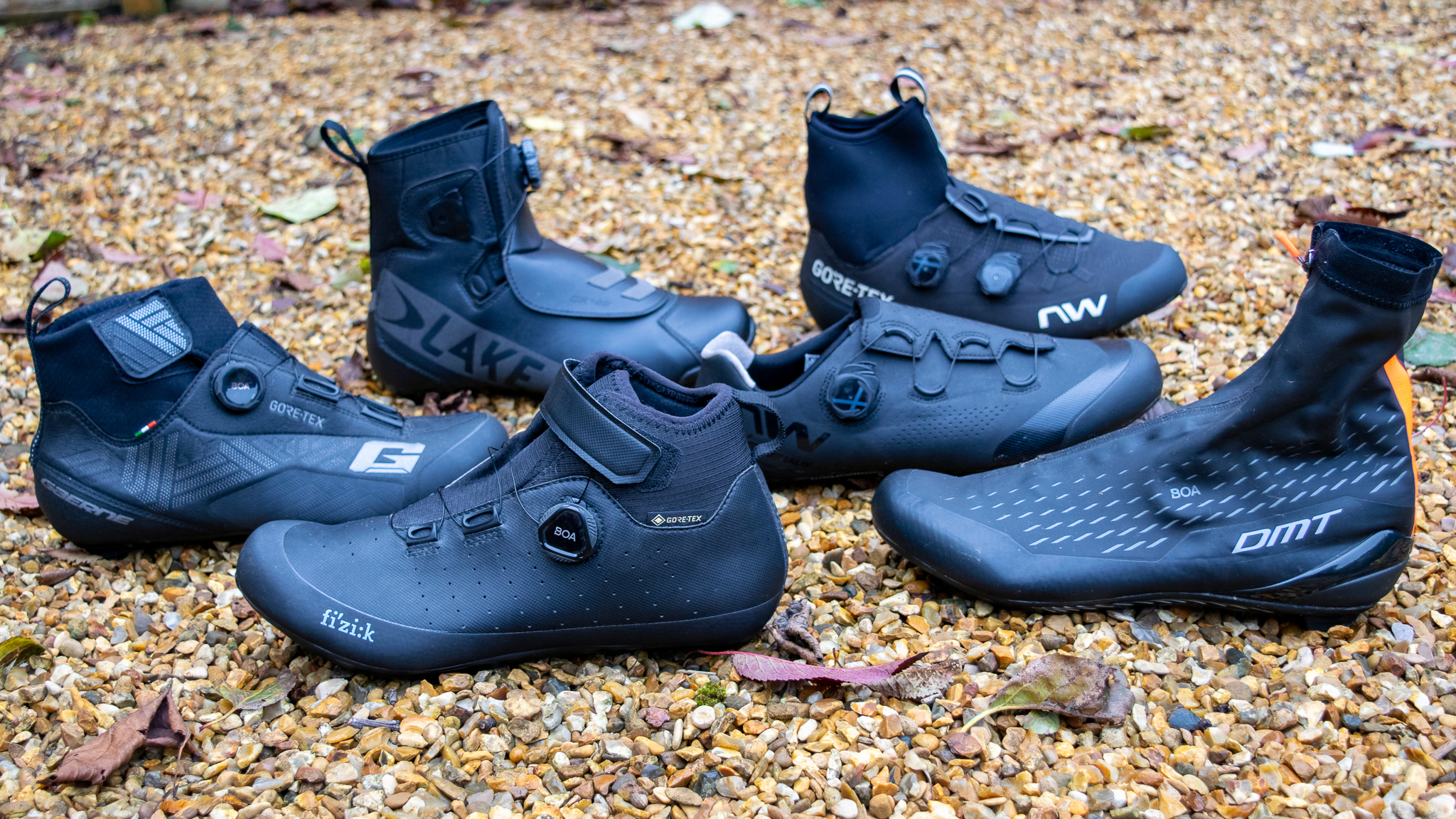
The best winter cycling shoes can add extra protection and warmth on colder and wet rides, especially in the depths of winter. Low temperatures and rain or road spray can leave you with cold feet, but winter-specific cycling shoes have specific designs and features to help improve foot protection on the bike.
If you are doing a lot of outdoor winter riding or commuting not only will a pair of the best winter cycling shoes keep your feet warm but they will also take the brunt of winter abuse, keeping your road shoes in good condition for the return of fairer weather.
Winter cycling shoes are generally a little bulkier than regular cycling shoes, especially in the 'boot style' which has a higher ankle for extra protection. Winter cycling shoes are available in on and off-road versions similar to what's on offer in our guide to the best cycling shoes or the best gravel shoes guide.
A good pair of winter cycling shoes are a cornerstone of how to keep your feet warm along with the best winter cycling socks. My pick of the bunch is the Northwave Magma R Rock shoes. Insulated cycling shoes that contain Primaloft Gold insulation. They have less bulk than some of the other shoes in the guide and pair really well with a range of overshoes if you want even more protection, which suits my riding really well. They are also one of the cheapest shoes in the guide, what's not to like?
Opinions seem to be generally split between using winter-specific cycling shoes or regular road shoes with a set of the best cycling overshoes. There are pros and cons to both and luckily we are blessed with many choices when it comes to kit in the cycling world.
Head to the bottom of the page for our guide on how to choose the right pair for you. There is also a lot of useful additional information we didn't have room for here.
QUICK LIST
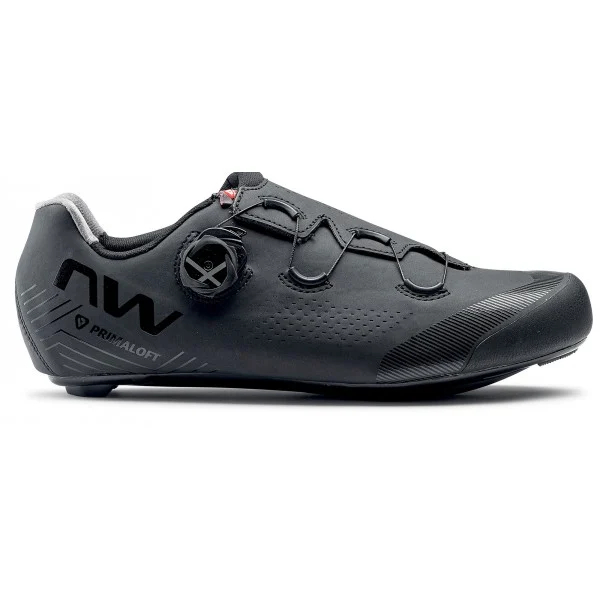
The Magma R Rock is a winter shoe that uses added Primaloft insulation for extra warmth in the cold. Warmth can be further boosted when paired with an overshoe.
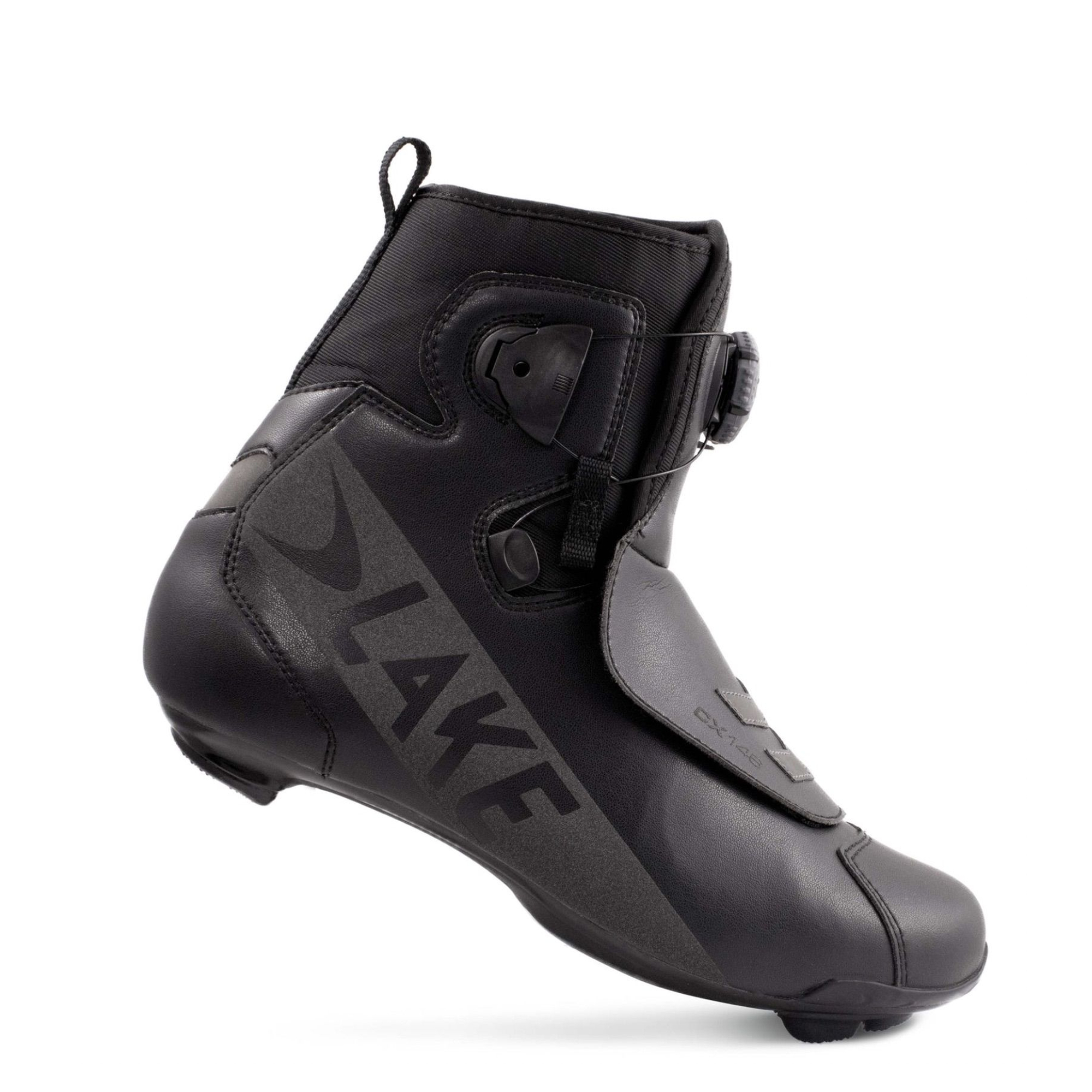
The Lake CX146 offers stout winter protection and may especially suit riders with wider feet or who do less intense riding.
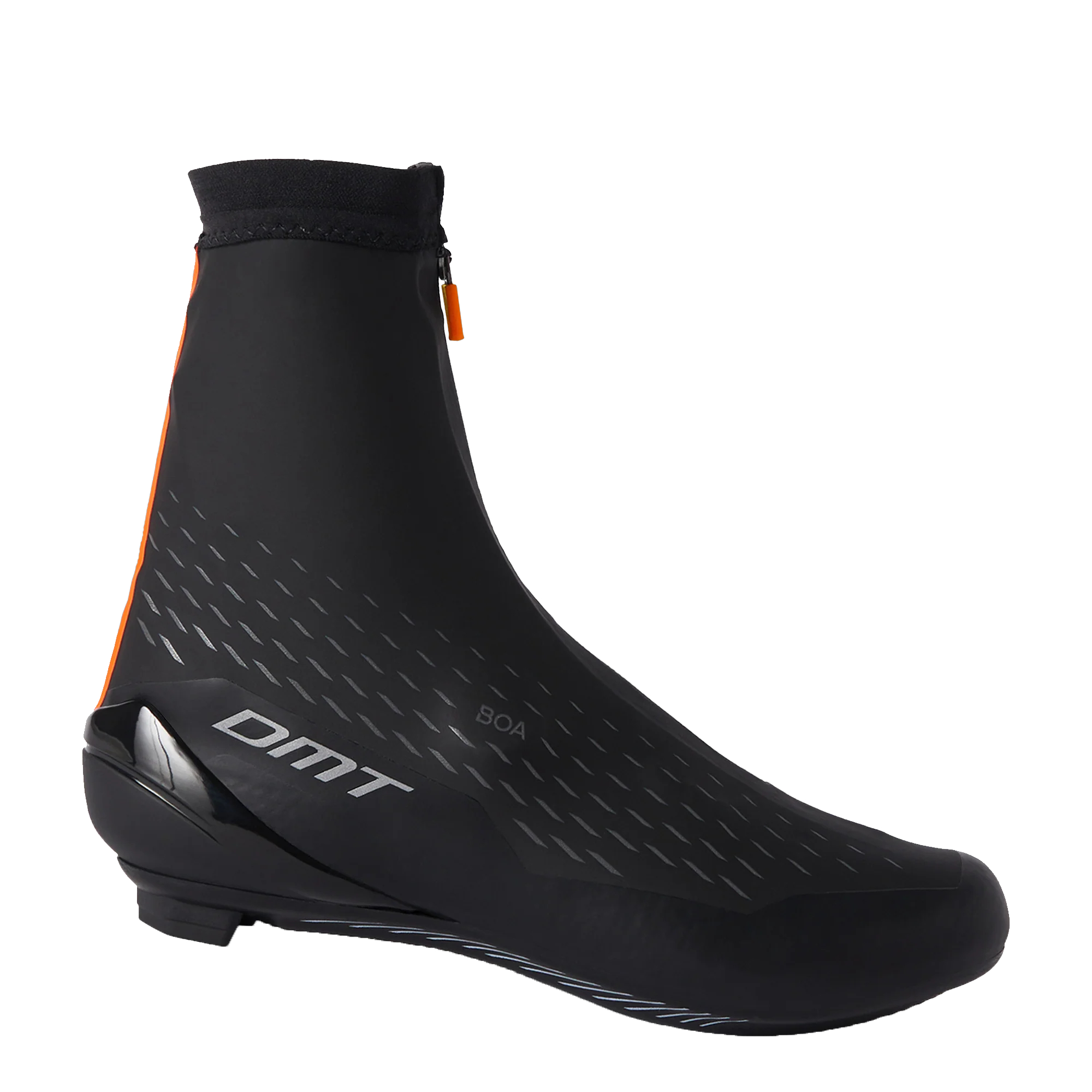
The WKR1 from DMT is a sleek winter shoe that features an integrated zip-up outer cover over a knitted DMT road shoe for added protection.
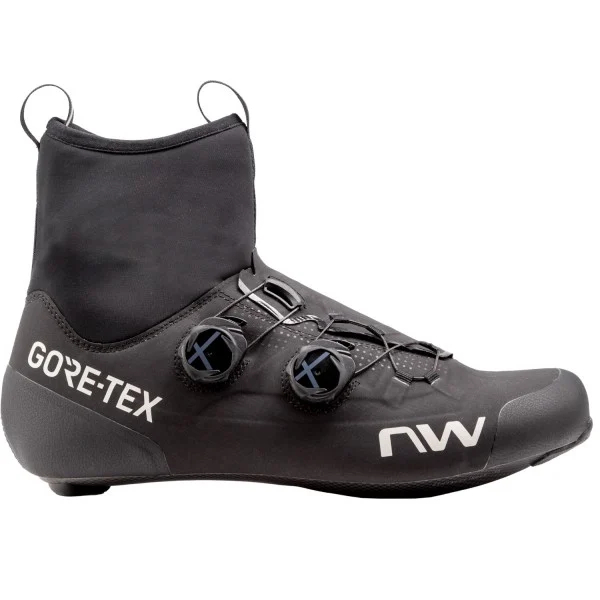
The Flagship R GTX are deep winter heavy hitters with a stiff carbon sole and a Gore-Tex liner.

The Tempo Artica shoes are fleece-lined winter shoes that also come in white for the fashionistas.
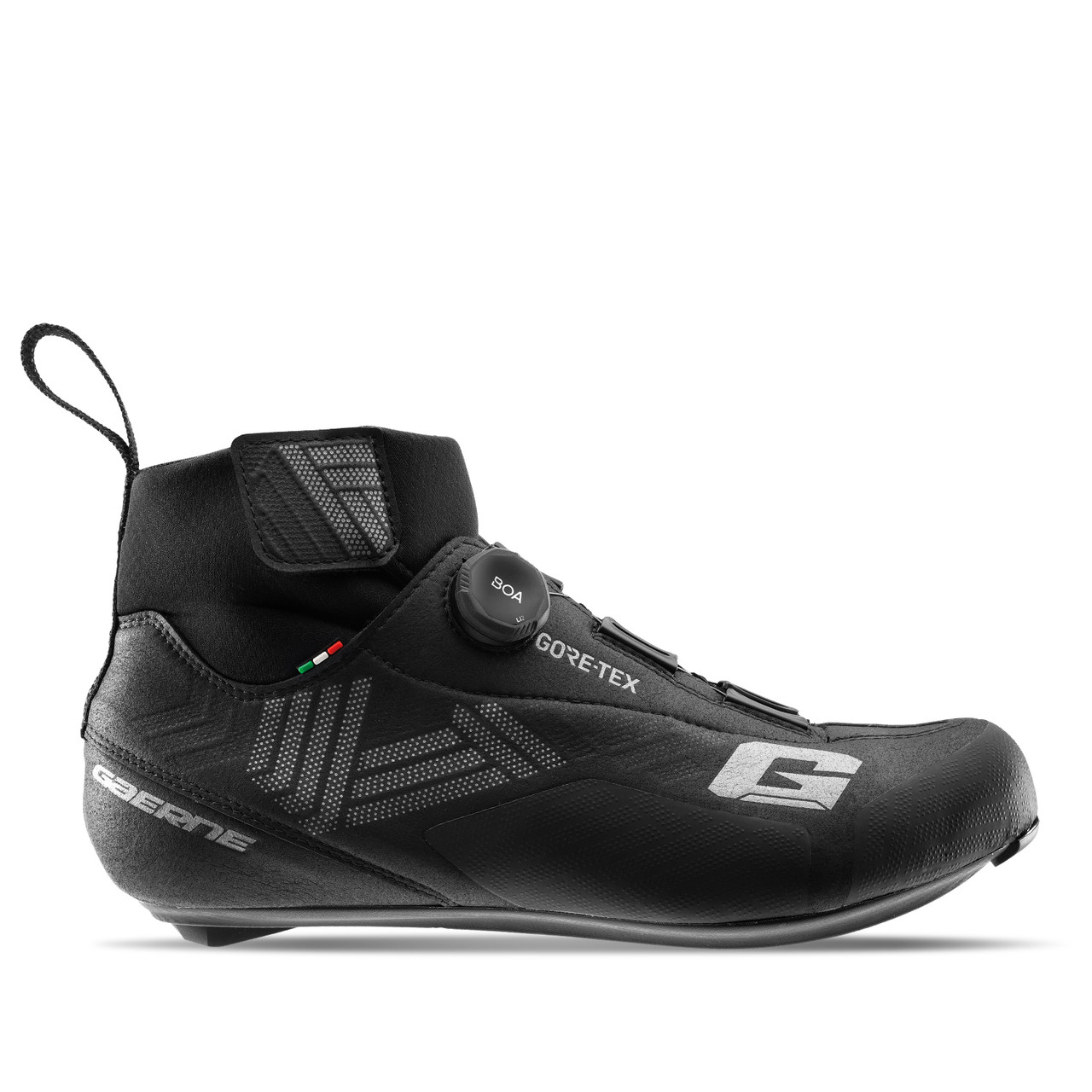
A winter road shoe from Gaerne with a Gore-Tex Rattler ankle Velcro strap collar for foul weather protection.
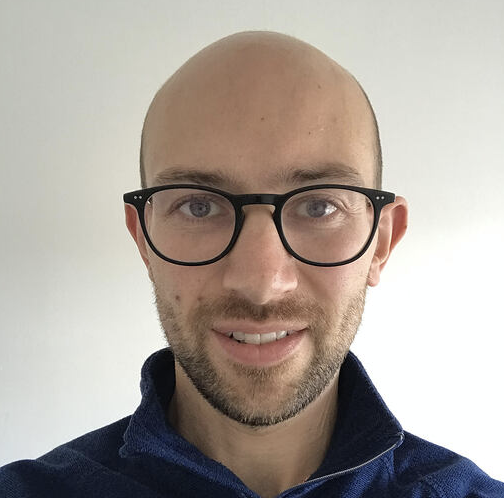
I have been testing winter cycling shoes for over two years, both in winter and warmer weather. I've tested over 10 pairs in the last several months and have deliberately tried them in wet and cold weather, riding through standing water and deep puddles whenever I see them to test their waterproofing and warmth.
We will all experience cold differently, but I've tried my best to test these shoes when riding at lower and higher intensities and in a range of conditions to provide Cyclingnews readers with the best possible buying advice.
Last updated on 25th of October 2024
For our latest update, we removed products that were outdated or no longer in production, added buy-if/do-n't-buy-if advice and completely new imagery for each product.
Best winter cycling shoes
You can trust Cyclingnews
Best overall
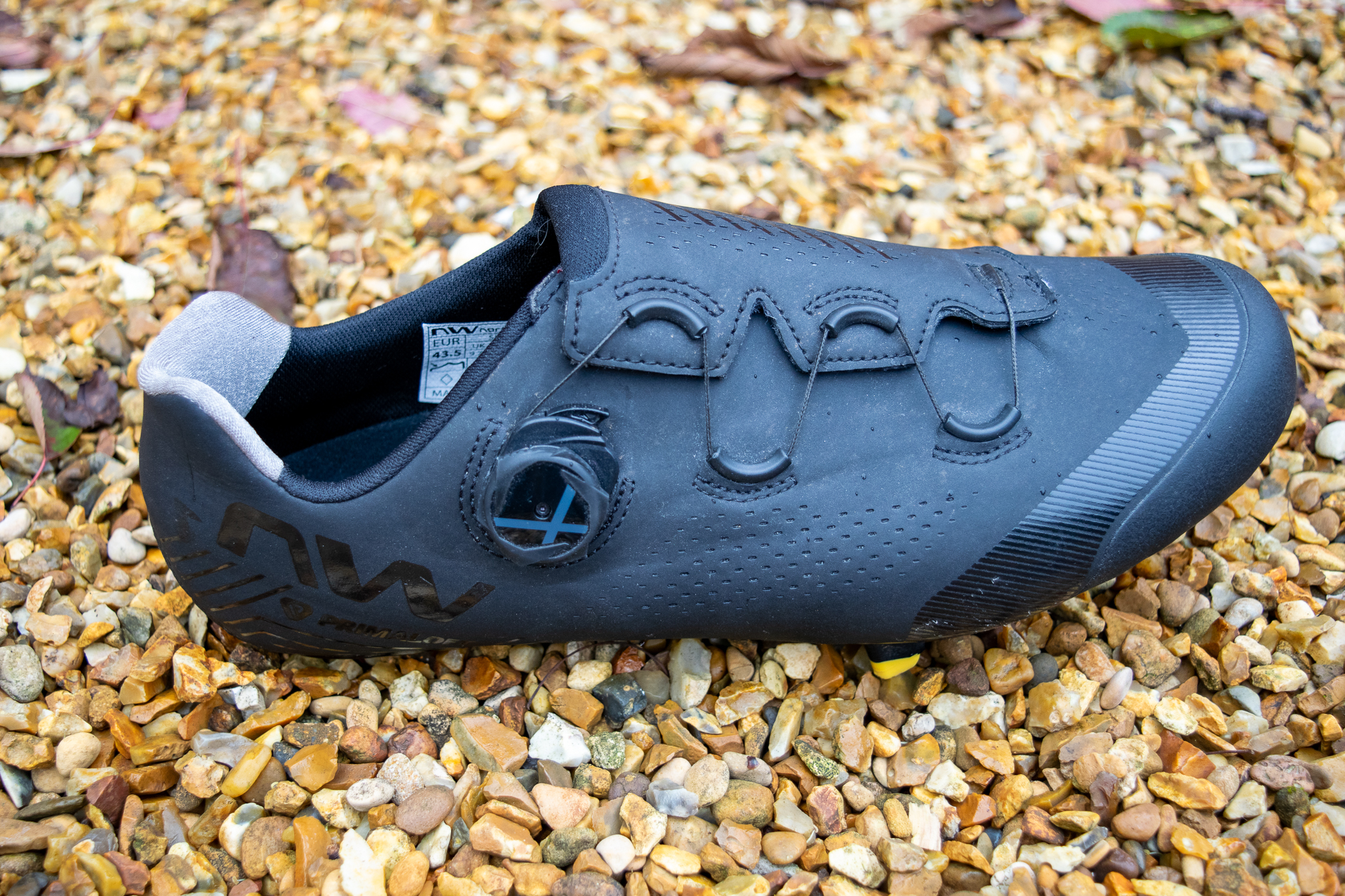
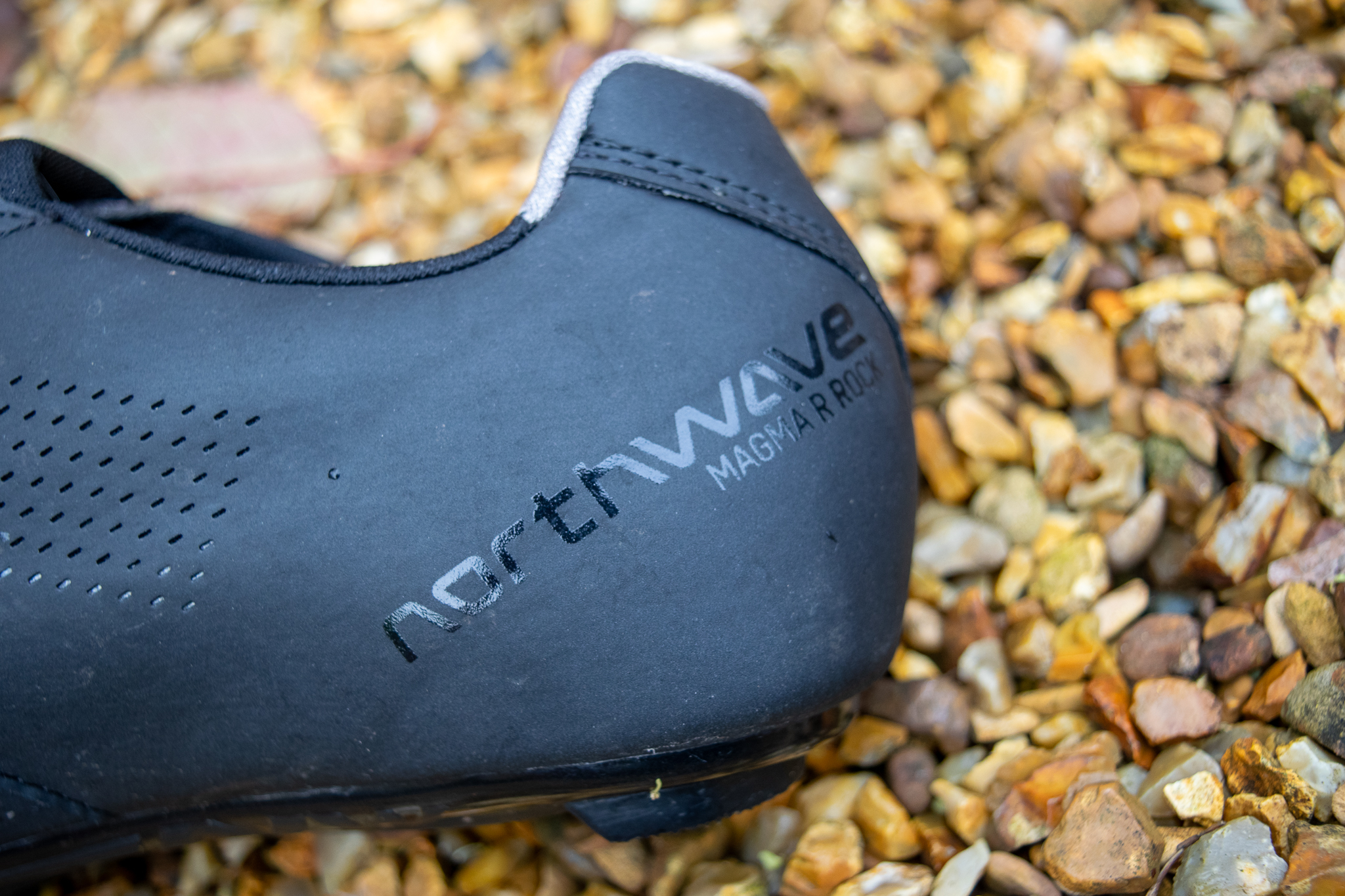
1. Northwave Magma R Rock
Specifications
Reasons to buy
Reasons to avoid
✅ You want warm feet: The Primaloft insulation and thicker insole help boost warmth when riding in dry winter conditions.
✅ You want a regular cycling shoe with added insulation: By foregoing an ankle gater or high boot cut gives the Magma R Rock a stylish look and low-bulk fit.
❌ You ride in the wet: The low-cut makes it easy for water to get into the top of the shoe, to keep your feet dry you will need to pair the Magma R Rock's with an overshoe.
A bit like the DMT WKR1 above, if a higher ankle, cuff and general added bulk of a full-on winter boot aren't what you need then the Northwave Magma R Rock shoe looks just like a regular cycling shoe but packs extra Primaloft Gold insulation and protection within the shoe to add warmth and comfort. Essentially, the shoes have built-in thermal insulation.
Unlike the Flagship R GTX above which gets the kitchen sink thrown at it, the Magma uses a nylon, three-bolt sole, and won't accept Speedplay four-bolt cleats. The shoes use a single SLW2 dial to tighten things down and there's a small red Primaloft tag near the tongue that hints at the extra insulation. The toe box is also a lot rounder and wider than some of the pointer ones here such as the Gaerne's so factor this in if it's a key point for you.
There are, however, cleverly added thermal features for not very much more weight. There's a thicker than average Northwave arctic insole which is soft and a sort of additional undersole beneath this which should aid warmth.
Inside the shoe is soft and cosy and I'd say the majority of the insulation is in the forefoot area and you can feel the extra plushness of the added material in a few areas.
On foot, they feel like regular cycling shoes so if you want things to feel a bit more nimble they are a strong option. They do feel warmer though in cold weather and were impervious to spray on my hose test where they got subjected to a soaking.
They also crucially will pair really well with overshoes and with a good pair will leave you with really warm feet. You can also pick them up for a little less money than a lot of the other shoes in this guide.
Best budget
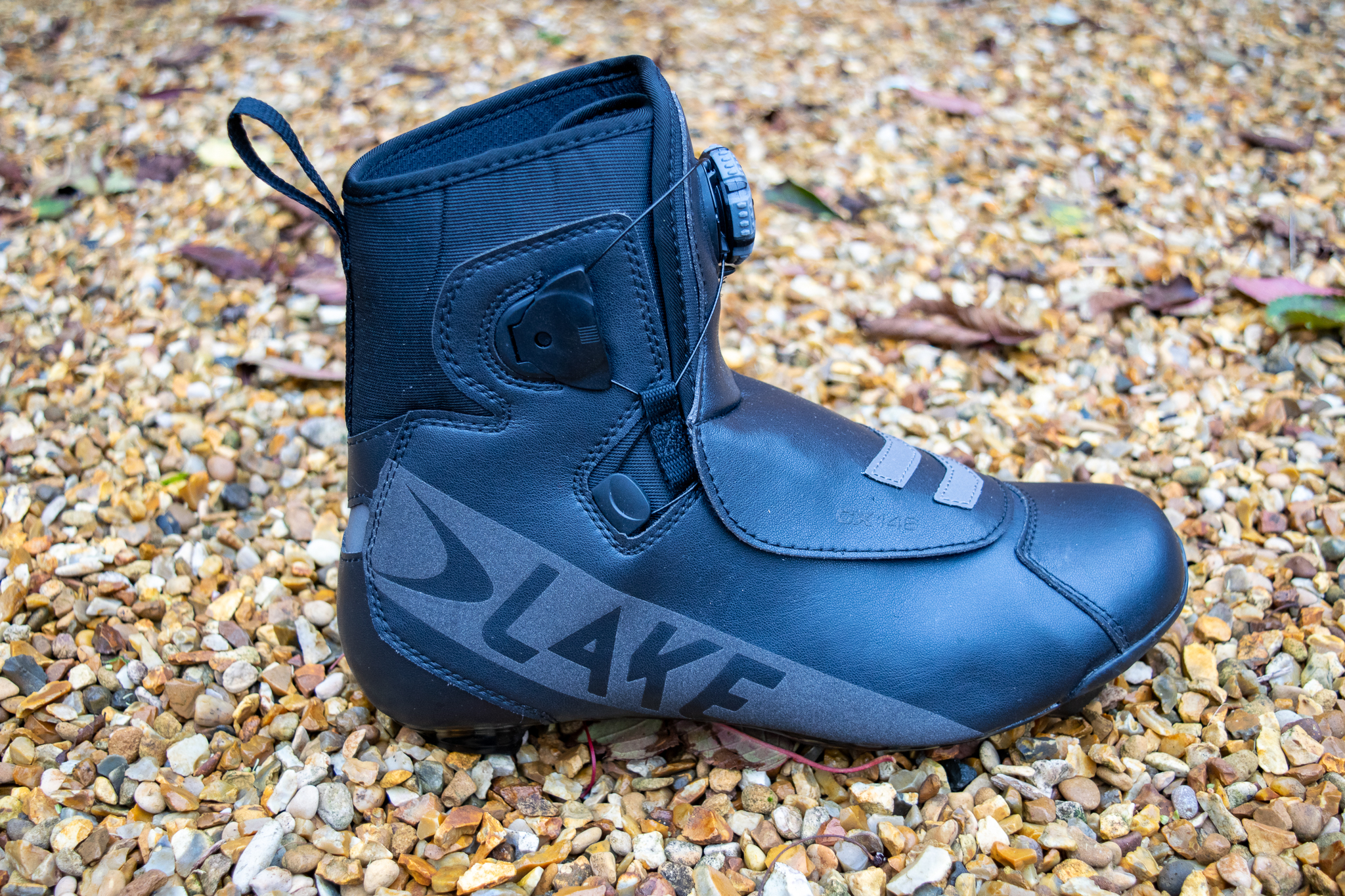
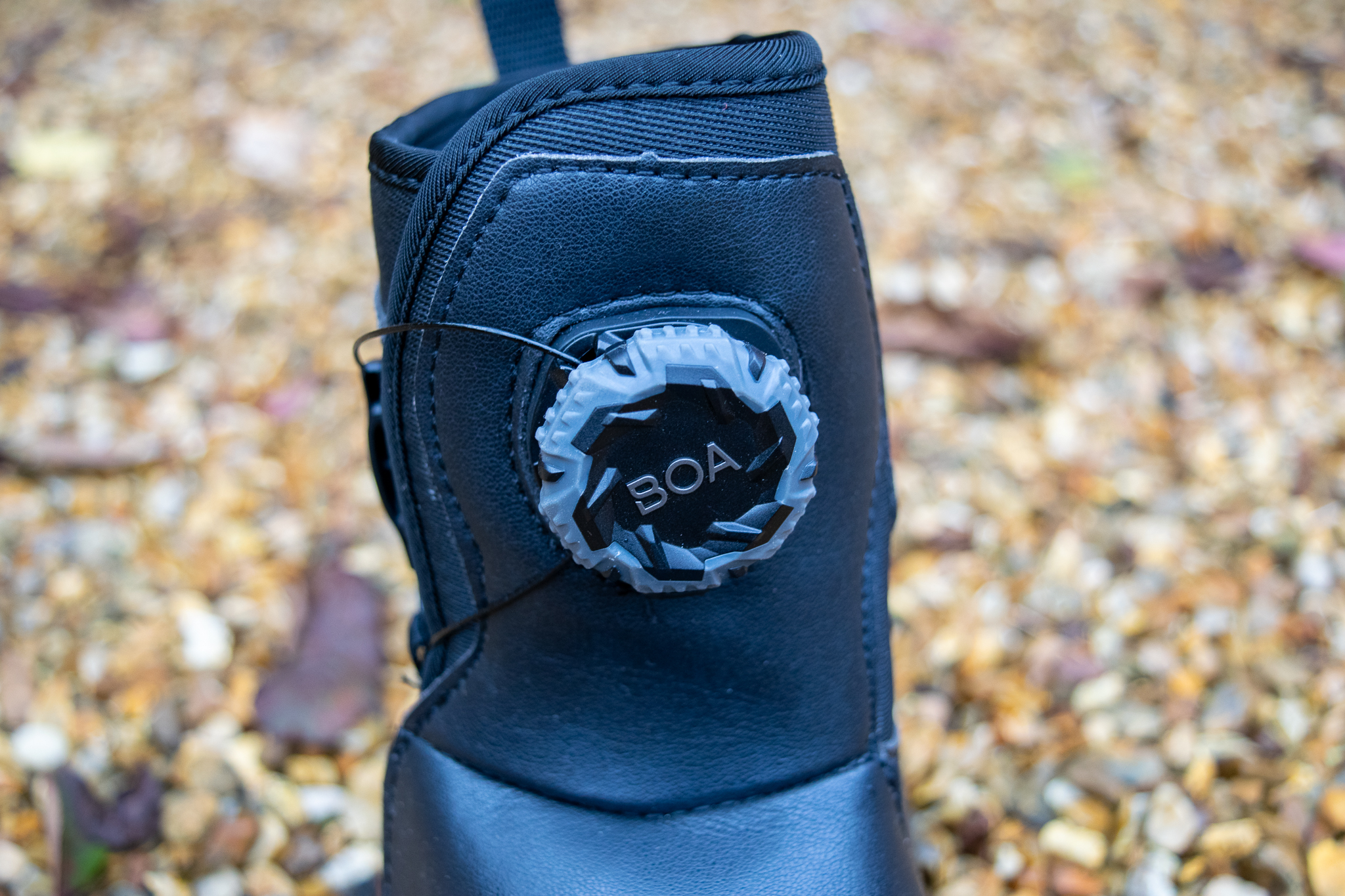
Specifications
Reasons to buy
Reasons to avoid
✅ You want a highly protective winter cycling shoe: The Thinsulate 200gr insulation, high cut and DWR coating microfibre uppers are effective against deep winter conditions.
✅ You want a wide-fitting shoe: Lake is known for having a wider fit and the CX146 comes in both regular and wide options.
❌ You have narrow feet: Lake's wider last might not offer the secure fit needed when riding. Those with narrow feet will be better suited to a shoe like the Gaerne G. Ice Storm GoreTex.
❌ You want to do fast winter riding: Stiff uppers give the Lake CX146 a sturdy feel similar to a walking boot.
The Lake CX146 is a hefty winter road cycling boot that's rated for use down to -4 degrees. Lake also offers it in a two-bolt MTB version, and it sits below the -20 rated MXZ400 in the temperature ratings, but that is a really specific deep winter shoe in the Lake winter range.
The CX146 is available in regular and wide options and the brand is well known for accommodating wider feet and focusing on fit and foot sizing. If you have really wide feet then you may want to take a look at the CX146.
The shoes have DWR coating microfibre uppers, which feel like leather. Use a large front velcro flap which closes over most of the single-dial BOA M4 closure system. There's some prominent reflective detailing and good-sized rear heel pull tab to help you pull them on.
The CX146 is the only shoe in the guide to use the burly BOA M4 dial, easily the largest BOA here and with a big textured gripper to make adjustments with cold or gloved hands easily.
The shoes have a walking boot feel about them, pulling them on makes you feel really protected and ready to face the elements. And though they won't be the best option for faster riding, for that look to the DMT or Northwave Magma options. If you want a quality option for the worst of the winter weather for a range of riding the CX146 will do well.
For winter training
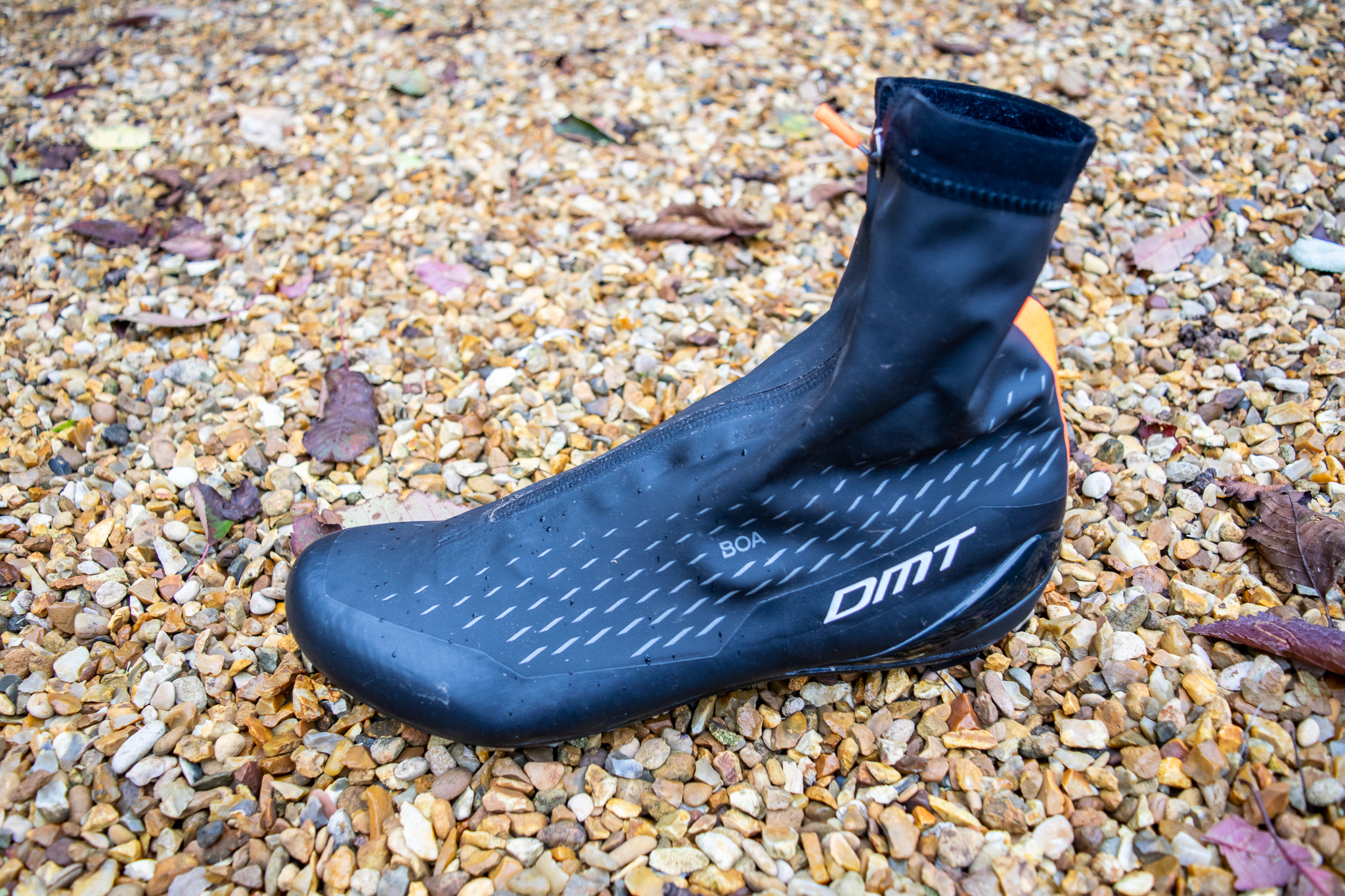
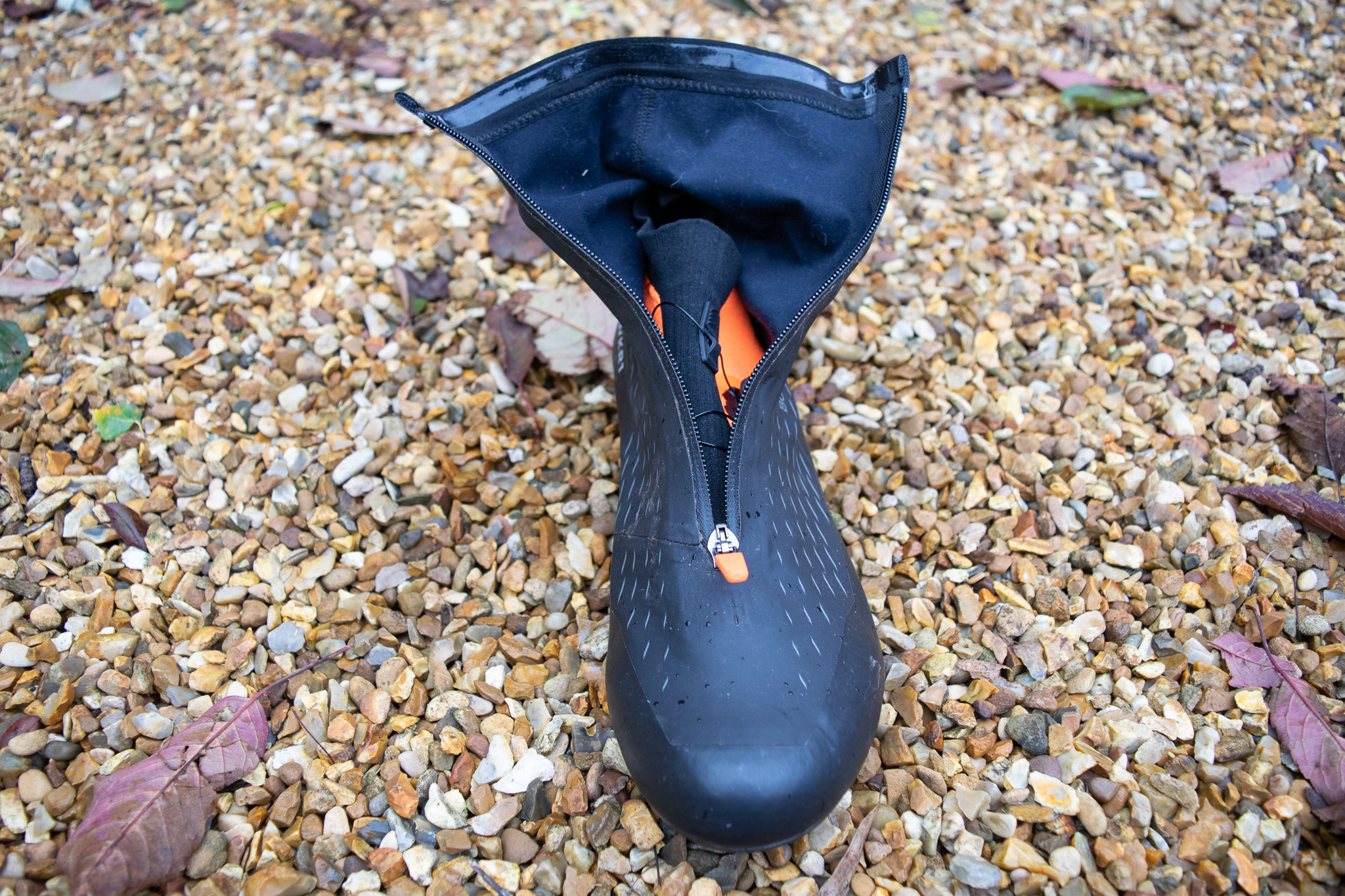
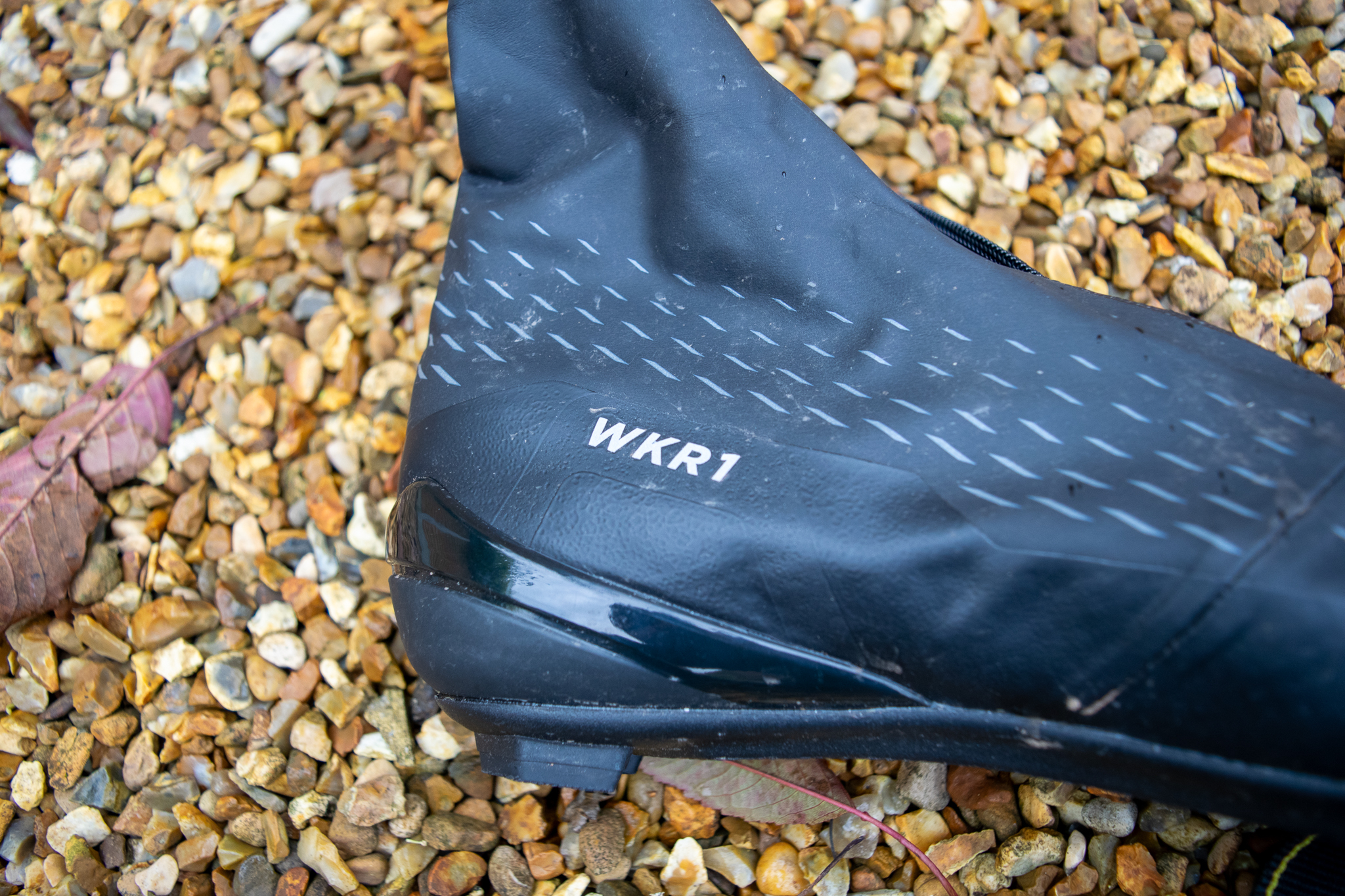
Specifications
Reasons to buy
Reasons to avoid
✅ You want a low bulk winter shoe: The DMTs are a less bulky shoe than some options here
✅ You don't mind narrower shoes: The DMTs may not be kind to wider feet
❌ You want all out warmth: There may be warmer shoes and even overshoe combos out there
Some winter cycling shoes can feel a little bulky and don't leave you feeling very fleet of foot on a ride.
If you are looking for something that's a little racier and has a silhouette that's similar to a regular road shoe whilst still adding protection you may want to have a look at the DMT WKR1.
Built around a three-bolt, nylon sole (there is a 2 bolts MTB version as well) the WKR1 is comprised of a woven 'inner' cycling shoe just like a regular road shoe you would see in the summer. But that is permanently attached to the soft shell outer layer of the shoe you can see. So you're getting a double layer of protection and essentially a thin incorporated overshoe.
The inner shoe which is bright orange, uses a single BOA Li2 dial for foot retention and the woven upper is comfortable and soft. The outer booty then zips up around it using a zip straight down the middle. You can even add an overshoe over the top if you want to.
I found the ankles a little loose but just tucked them under my bibtights which helps prevent water ingress. They kept my feet dry over a horrid two-hour ride in the wet. I would recommend sizing up as the WKR1s do run a little narrow, and you'll probably want a bit more wiggle room for thicker socks in winter.
For deep winter
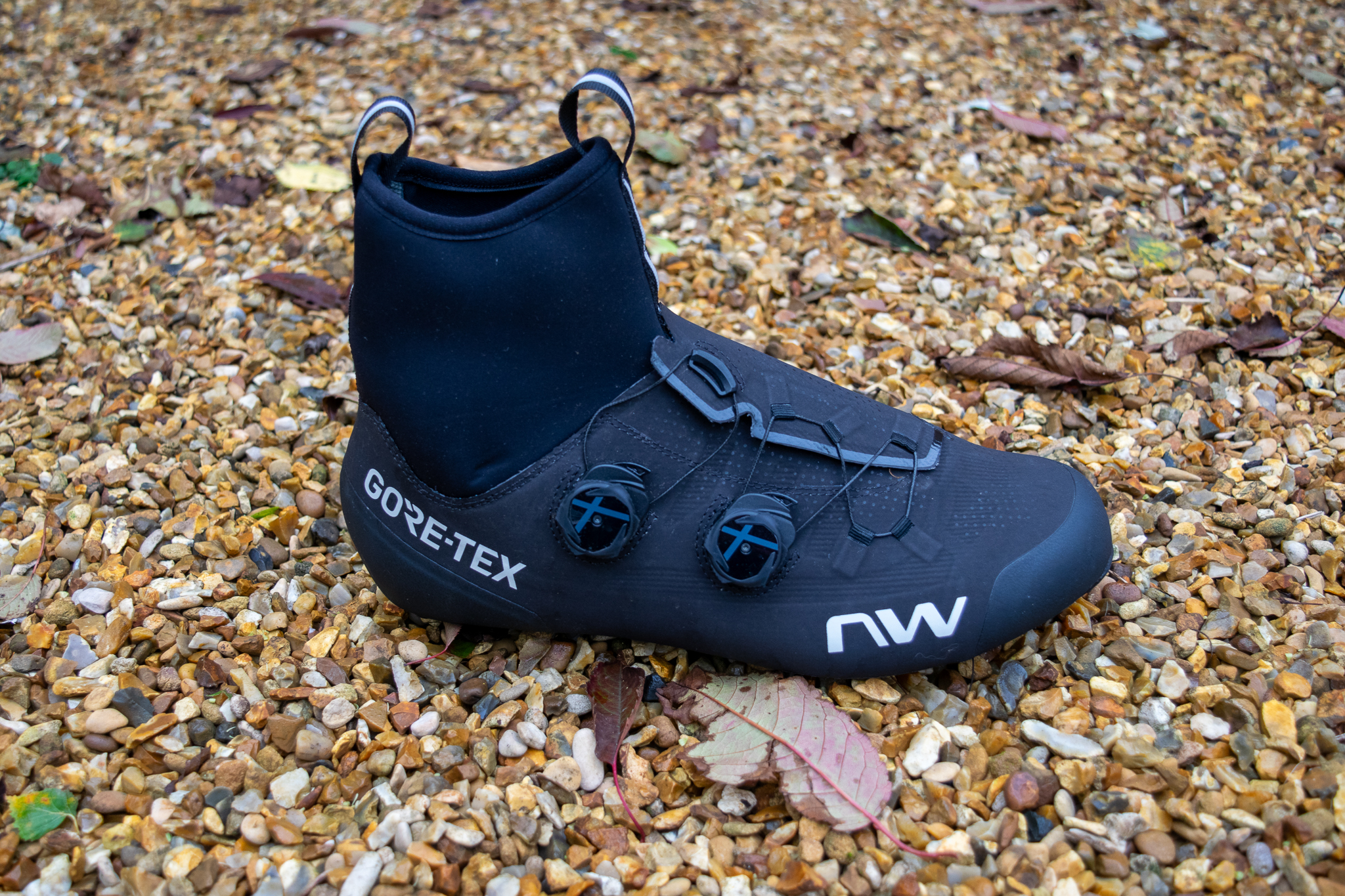
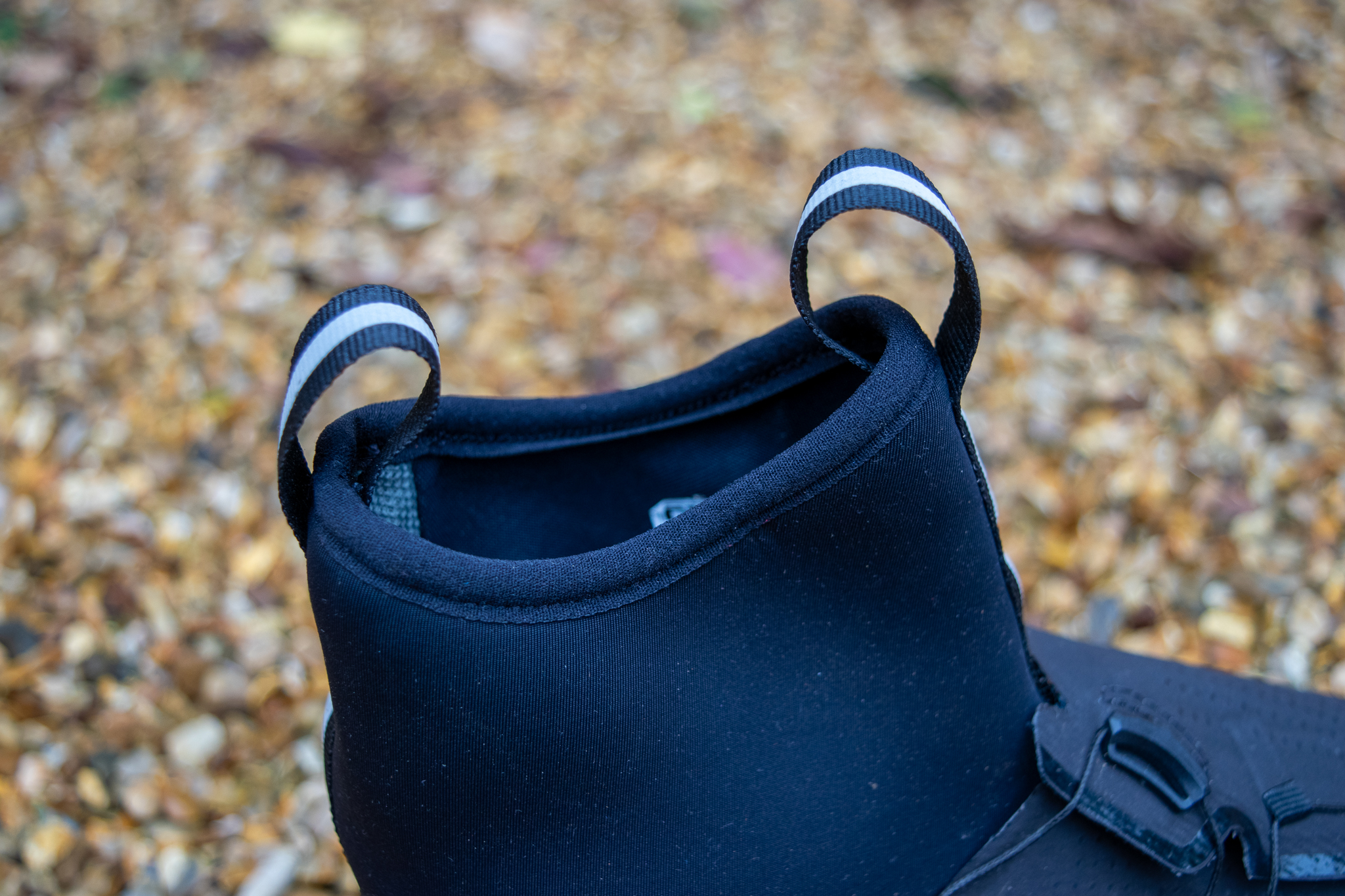
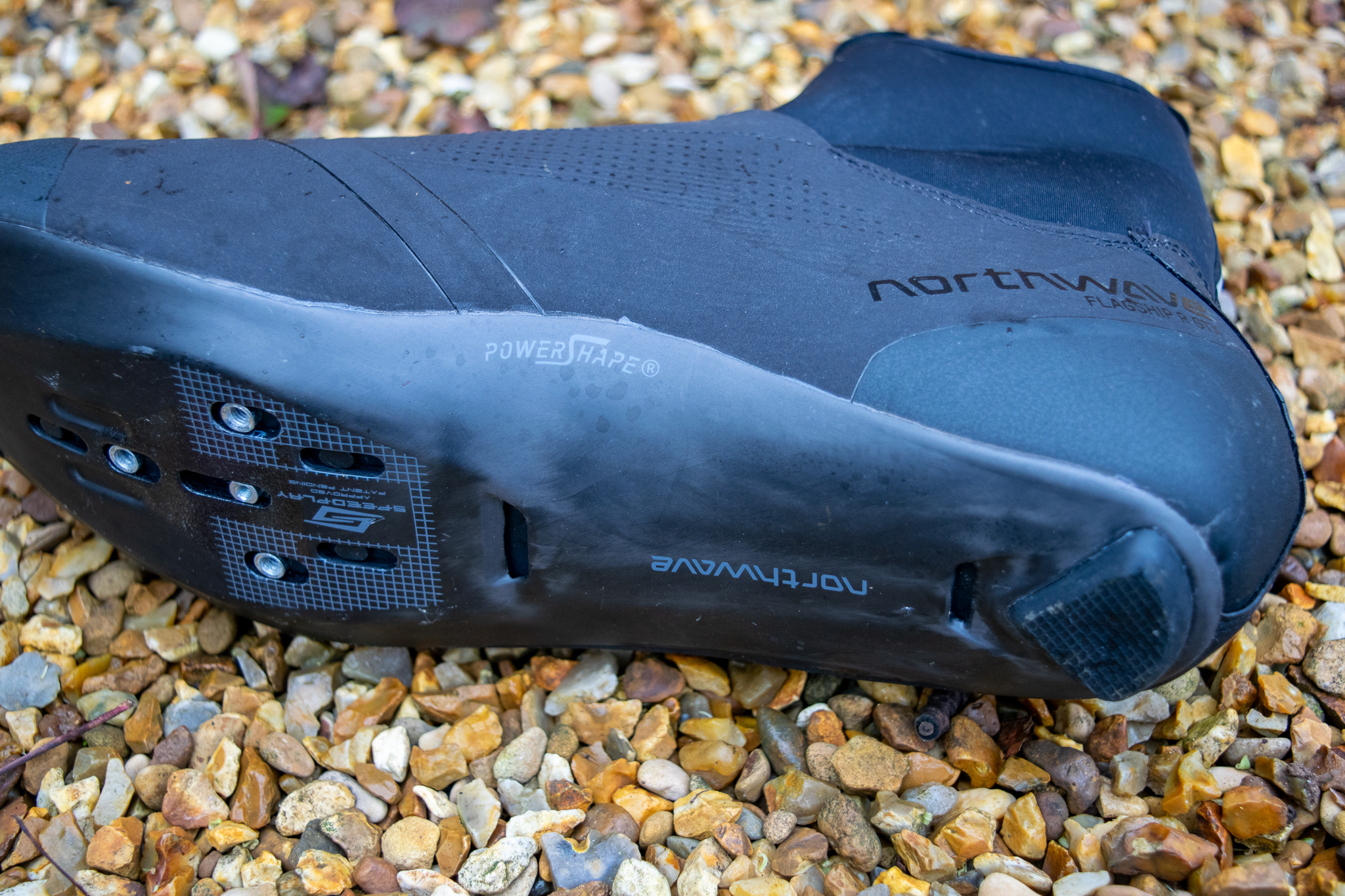
4. Northwave Flagship R GTX
Specifications
Reasons to buy
Reasons to avoid
✅ You want to ride in sub-zero conditions: The Gore-Tex Duratherm Kelvin membrane liner is said to be good for down to -15 Celcius.
✅ You want a stiff shoe: Northwave's PowerShape carbon sole is at the top of the brand's stiffness rating.
❌ You are on a budget: Premium materials and top tech make these flagship shoes an investment that is likely only justifiable for the keenest winter riders.
The clue's in the name with the Flagship R GTX from Northwave, and the brand's range-topping winter shoe is a bit of a beast.
Winter shoes sometimes omit more performance-focused design features such as carbon soles. But this isn't the case here, and the R GTX benefits from Northwave's PowerShape carbon sole with a stiffness rating of 15, the top level on the brand's stiffness rating.
There's also a Gore-Tex Duratherm Kelvin membrane. In simple terms, this is the heavy-duty Gore-Tex liner used inside the shoe. Northwave says it's good for down to -15 Celcius.
On the feet the shoes are really comfortable and Northwave sizing is on the generous side of things I would say, though the shoes also don't feel that bulky which I liked. I tested an EU 43.5 which equates to a UK 9.75 with Northwave and it felt just right for a winter shoe. You could also get an overshoe on over the shoes if you wanted and the right pair would create a really formidable combo.
They feel comfy and snug inside and the neoprene ankle gaiter is soft. The last time I rode in them was on a single-digit, showery day after a period of intense rain had left lots of puddles and some flooded roads. Crossing one deep flooded section meant water coming into the shoes via the 'Easyfit collar' ankle openings, but they dealt with it well and my feet stayed comfortable. A tighter ankle fitting would help prevent water ingress here and is something I think I would prefer, but I don't ride through floods very often. Water didn't penetrate the outers at all really and my hose test didn't bother them.
All this tech does come at a cost though and the shoes are more expensive than the Veloce Extreme top-end road shoes we reviewed last year. But if you want a top-end pair of winter shoes with a load of tech, step this way.
Boots with colour options
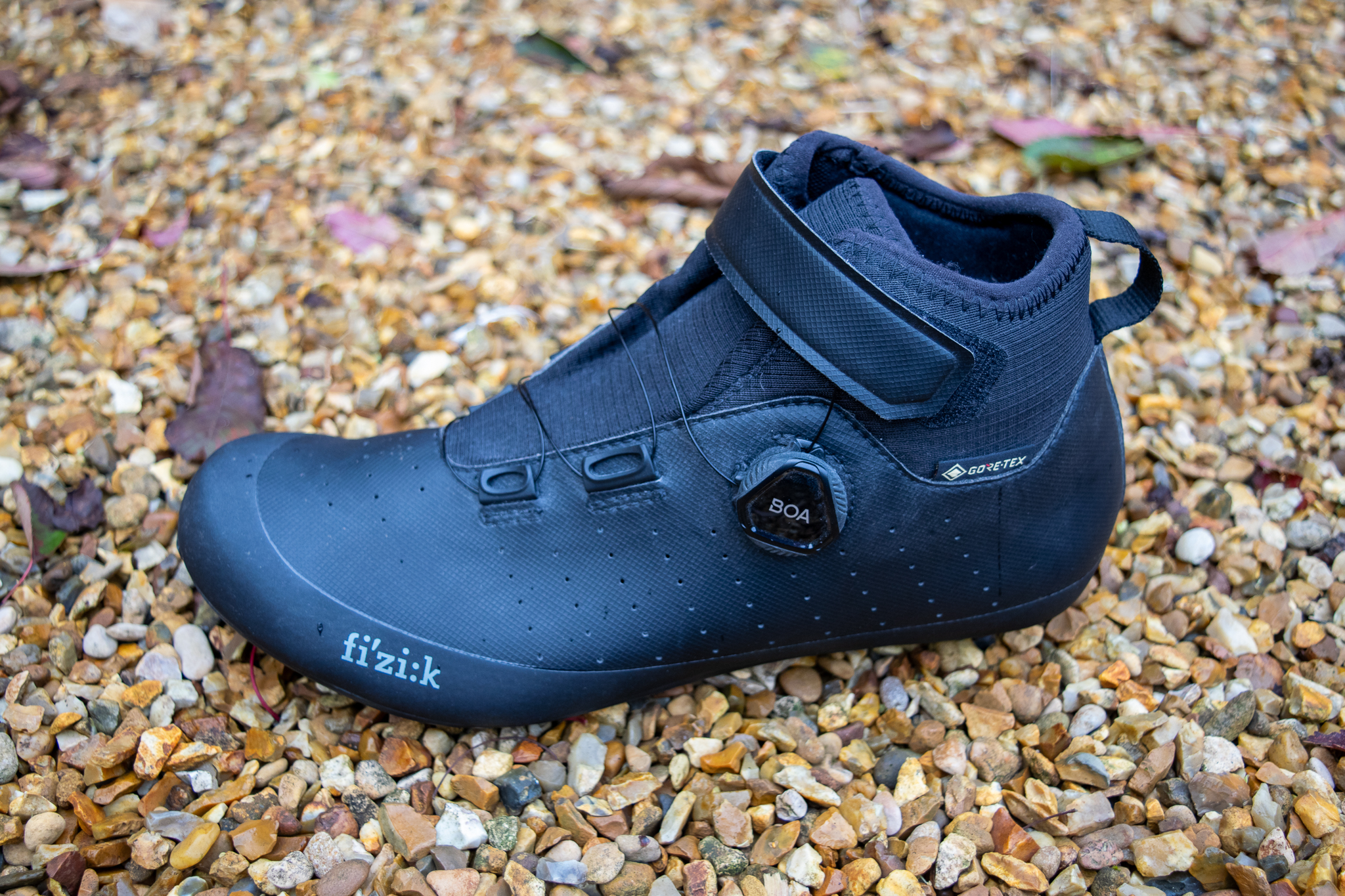
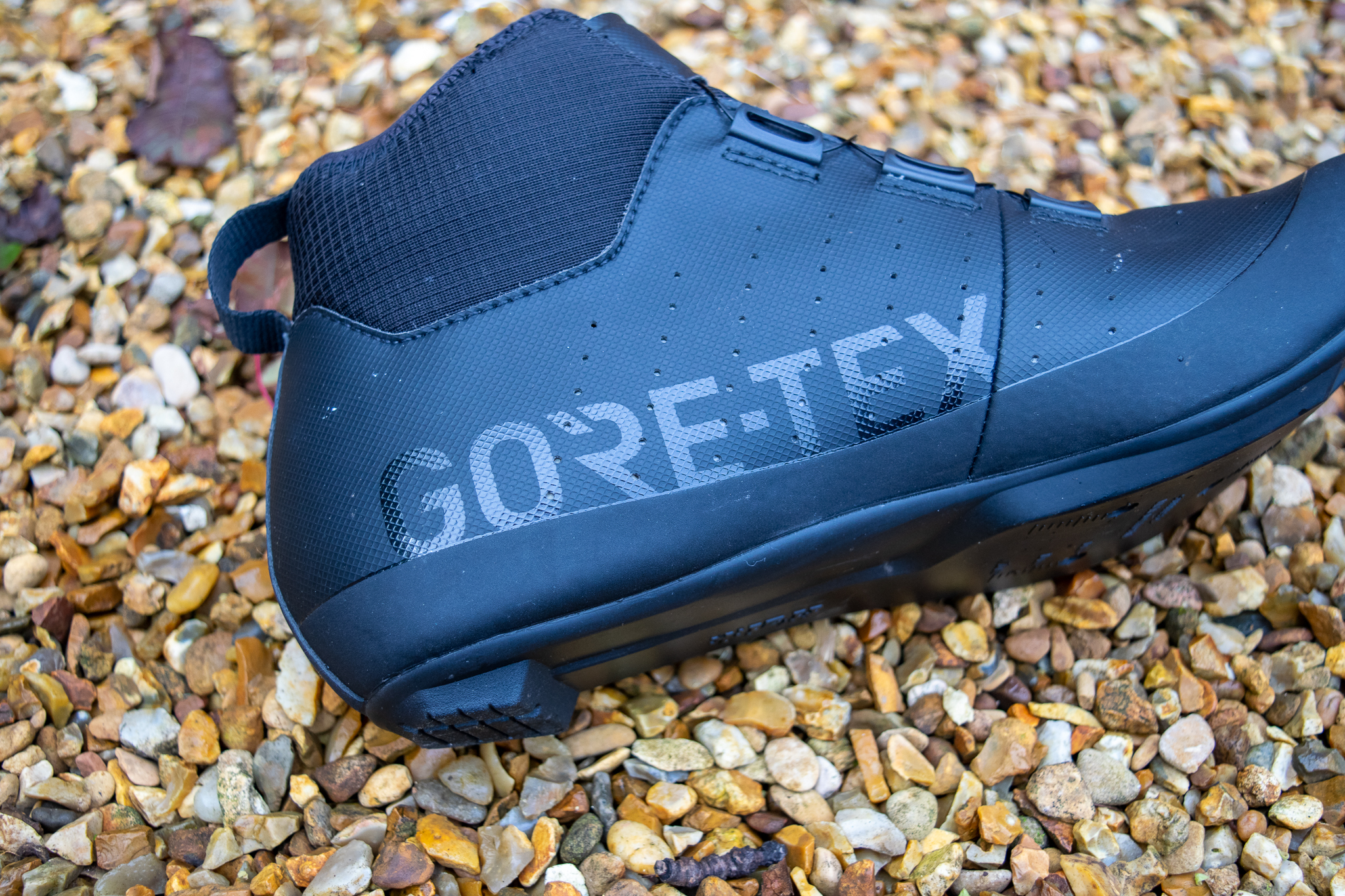
5. Fizik Tempo Arctica GTX
Specifications
Reasons to buy
Reasons to avoid
✅ You want a low-bulk lightweight shoe: Fizik has done a great job at giving these a slimmer silhouette whilst still offering great winter protection.
✅ You want white shoes: As far as I am aware these are the only winter shoes available in a crisp white colourway.
❌ You want guaranteed dry feet: The ankle is short making it difficult to seal against the rain.
The Fizik Tempo Arctica GTX is a new release from Fizik and is available in the standard black and, in a somewhat surprising move for a dedicated winter shoe, a bright white option. We aren't aware of any other white winter boots, and if white shoes are your thing or you just want to feel a bit faster during the winter months, the white version may be the one to go for.
The Arctica GTX has a nylon sole with a three-bolt cleat drilling and no vents to prevent water ingress. The sole features moulded nylon heel and toe tabs that are non-replaceable. If you do some walking in your shoes, keep this in mind. There is also a small pull tab on the heel to help you get them on easily.
The shoes make use of a single L6 Boa dial and ankle closure Velcro strap, which helps things feel secure. Though the L6 Boa doesn't offer quite the same level of fine adjustability that the Li2 unit on the Gaerne shoes offers. The outers feature a Gore-Tex waterproof membrane and are claimed to be fully waterproof. Inside, there is a brushed fleece lining which extends down under the insole, which should help keep feet snug. The insoles themselves are also slightly fleecy which is a nice touch and the shoes feel cosier when you first put them on than the other winter shoes in the test.
The Arctica GTX feel closer to regular road shoes than a lot of more traditional winter boots and if you don't want to go the whole hog their slimmer silhouette might be a nice middle ground whilst still offering great winter protection. Don't be fooled into thinking Fizik have just glorified road shoes though - these are warm, comfortable winter boots.
For a more detailed look, check out our Fizik Artica GTX review.
For narrow feet
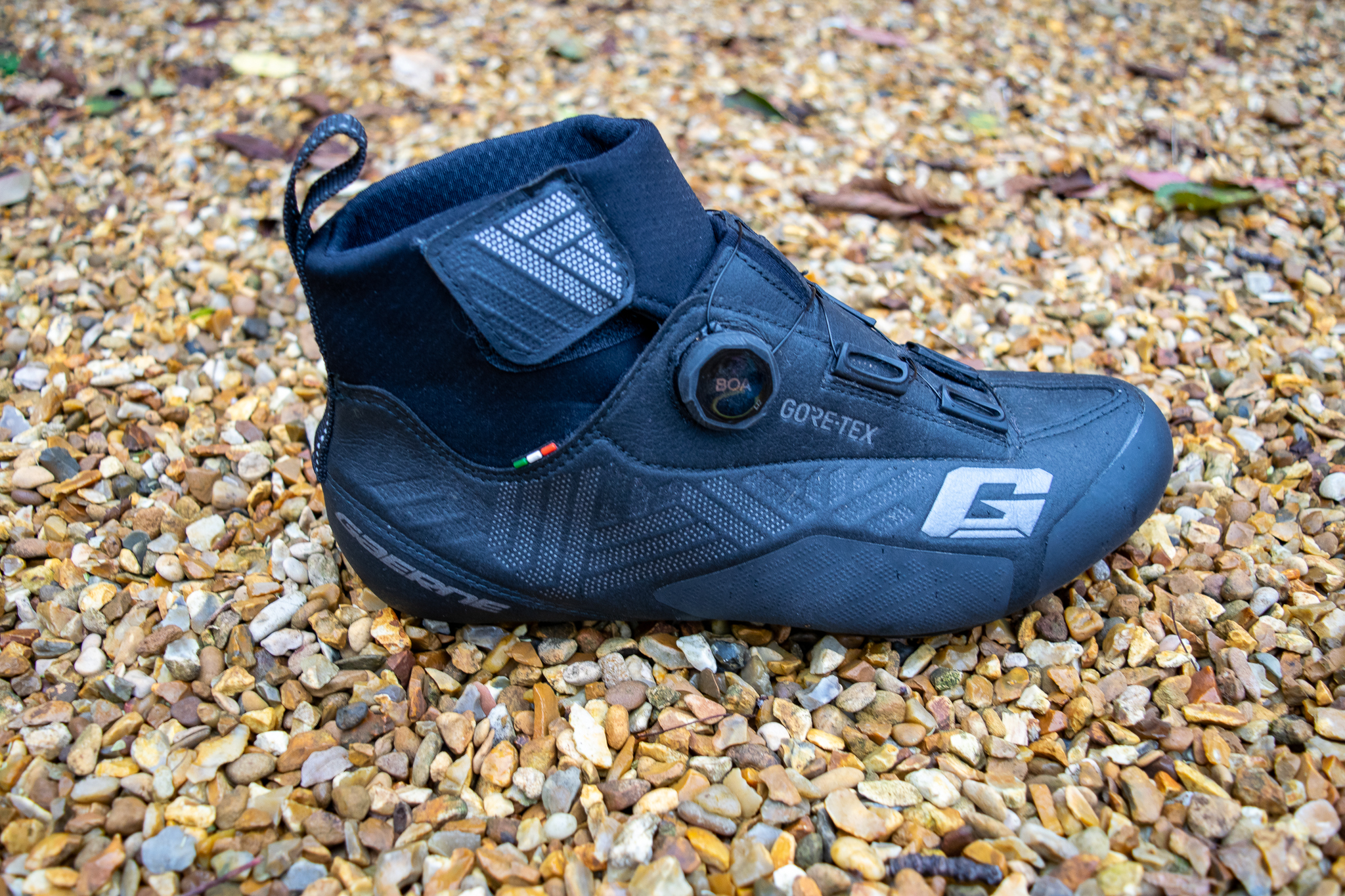


6. Gaerne G. Ice Storm GoreTex
Specifications
Reasons to buy
Reasons to avoid
✅ You want a waterproof pair of winter boots: A combination of Gore-Tex Duratherm membrane and Gore-Tex Rattler ankle Velcro strap collar keeps the elements out.
✅ You want a stiff carbon sole: Gaerne has equipped the G. Ice Storm GoreTex with a carbon sole for a stiffer pedalling platform.
❌ You have wide feet: The narrow fit may be too tight for those who prefer a wider-fitting shoe.
❌ You frequently ride in sub-zero temperatures: Overshoes or thicker socks are needed in very cold conditions.
Gaerne's G. Ice Storm 1.0 Gore-Tex winter shoes are available in both MTB and road versions, sharing the same Gore-Tex upper and ankle cuff, but I tested the two-bolt road versions this winter. The shoes are built around a carbon composite sole which Gaerne rates as an 8 out of 12 on their stiffness scale. It uses a Gore-Tex Duratherm membrane which locks in warmth and keeps out the wet, while the Gore-Tex Rattler ankle Velcro strap collar closes the shoes at the ankles.
The Ice Storm shoes feel solid and dependable on the feet. A large pull tab on the heel helps you pull them on in seconds. There's something of a double tongue on the shoes, which really adds to the feeling of protection from the winter elements. The inner membrane has a tongue that folds over your foot, but the outer of the shoe has a second that then covers this. The Boa wires also run through this.
Interestingly, the Gaerne shoes have five fairly large sole vents to offer some breathability, which is something neither the Sidi or Fizik Artica GTX shoes have. If you are not sweating excessively or riding slowly in cold weather, this could contribute to your feet becoming cold more quickly.
This tongue design will definitely offer some extra protection, and I found I had to get used to tightening the Boa down more than I thought I needed to cinch the plush tongue down enough to achieve a snug fit. The shoes were warm and comfortable and didn't feel hugely bulky. I did use them on one sub-zero night when the temperature was around -3C/27F, and my feet did feel cold after around an hour. This may have been partly due to the narrow and slightly pointy toe box. The Gaernes represent a solid winter boot if you are in the market for a pair, but at or around freezing conditions, you may want to consider adding overshoes or thermal socks into the mix to keep your feet warm. If you also have a wider foot or prefer wider shoes, you may want to size up or choose a wider offering.
How to choose
Do I need winter cycling shoes?
Winter shoes are a nice bit of kit to have in your winter arsenal. If you fancy a pair to wear in grotty or cold weather go for it.
However, if you have other priorities and cycling kit to spend your money on, you can always go for regular shoes paired with good-quality overshoes. The money you save could be spent on next year's summer tyres.
If you want some winter-specific shoes but don't have an unlimited budget, check out the Northwave Magma's you may be able to get a deal on them and they are quality shoes that do add warmth and comfort.
At the other end of the scale, if you have cash to splash and want a top-end winter shoe, go for it. They will prove useful in the deep winter and boost morale.
How should my winter cycling shoes fit?
Firstly, and most importantly, is to find a shoe that fits. It seems obvious, but bear with us. A shoe that hurts your feet at room temperature is going to be exponentially worse in the cold, so it's essential to find a pair that fits comfortably and that isn't too narrow.
Like shopping for a road shoe, it's important to find some shoes that fit your feet properly. After all, everyone's feet are different. It's a good idea to try shoes before you buy at a local shop but if you can't do this use the brand's sizing guide and even send them an email to enquire about sizing if you aren't sure.
If you do want to allow for a bit of extra room for airflow and or heavier-weight socks then you could always leave your shoes a little looser. A whole size difference may affect the ability to achieve optimal cleat positioning.
Do I need a carbon fibre sole for winter cycling shoes?
You don't need a carbon fibre sole for winter shoes and the majority of shoes in this guide don't have one. It would result in an even more expensive shoe for a start.
If you want a stiffer shoe or still ride hard in the winter on chain gangs etc then a carbon sole may be preferable for you, such as the one on the Northwave Flagship model.
How tall should my winter cycling shoes be?
This is a tricky one and in my opinion, ankle designs and openings are the closest thing winter shoes have to an Achilles heel.
If a boot-type overshoe has a higher ankle collar that is a little more open, that may make it more vulnerable to water penetrating the shoe in that area. Either from rain or spray or water from soaked tights running down into your shoes. Potentially leaving you with cold, wet feet. A bulkier ankle area also makes fitting an overshoe difficult or unsightly at times. Yet the overshoe is the very thing that could help seal this area and aid waterproofing.
There is a range of shoes in the guide from the Northwave Magma shoe to the Sidi 'boot' style option. In general, I'd recommend going for shoes with a more fitted ankle opening. It's also worth bearing in mind whether you want to pair overshoes with the shoes or not and how easy this will be to do.
Which cycling shoe retention system is best?
Among the best winter cycling shoes, you'll find Boa dials, and Velcro and some even have the fast lace system commonly found in MTB shoes.
Every shoe in this test has a Boa or wire closure system and some shoes like the Fizik's pair this with a velcro strap or closure, typically around the heel. A boa system allows you to generally achieve a more comfortable fit and achieve it very quickly. Laces on a winter shoe would not work as well the same can be said for velcro.
FAQ
Are winter cycling shoes worth it?
Full disclosure, if you're doing a lot of outdoor cycling in cold conditions and maybe a bit of commuting too, winter shoes are probably going to be worth it for you.
If your not logging tonnes of miles outside, live in a warmer place or tend to ride at a higher intensity which generates more heat and places an emphasis on lighter kit your going to be just fine in road shoes and overshoes for when it's cold and wet.
How can you keep your feet warm when cycling in winter?
Ah, the classic question!
There are a few different things you can do to help ensure your feet stay comfortable during cold winter riding and we cover some of them in our best cycling overshoes guide.
Let's start before you leave the house, ensure your feet are warm and you are wearing some warm socks. Padding around in the garage barefoot and getting ready won't help. Also, warm up your shoes before you ride. Leaving them in a cold garage or porch the night before etc won't help as they will be chilly when you pull them on.
Use some quality overshoes or winter cycling shoes as we've been discussing here will also help hugely during the ride.
You can also use things like windproof socks, and embrocation on your feet and leaving your shoes a little looser should also promote airflow.
How do we test?
I have researched each shoe in the guide, sending any technical questions I have had to the brand representatives themselves.
I've inspected, weighed and photographed each shoe and then ridden in them in a range of conditions, deliberately trying to go for cold, wet or rainy conditions to test their capabilities.
I've also subjected them to a garden hose shower test to put their water resistance to the test. To gain an understanding of how they stand up to spray and rain I used a light 'shower' hose setting to try and replicate rain and spray, rather than just blasting them like a pressure washer.
The latest race content, interviews, features, reviews and expert buying guides, direct to your inbox!

Tom joined the Cyclingnews team in late 2022 as a tech writer. Despite having a degree in English Literature he has spent his entire working life in the cycling industry in one form or another. He has over 10 years of experience as a qualified mechanic, with the last five years before joining Cyclingnews being spent running an independent workshop. This means he is just as happy tinkering away in the garage as he is out on the road bike, and he isn’t afraid to pull a bike apart or get hands-on with it when testing to really see what it’s made of.
He has ridden and raced bikes from an early age up to a national level on the road and track, and has ridden and competed in most disciplines. He has a keen eye for pro-team tech and enjoys spotting new or interesting components in the wild. During his time at Cyclingnews, Tom has already interviewed some of the sport's biggest names including Mathieu van der Poel, Tadej Pogačar and Alberto Contador. He's also covered various launches from brands such as Pinarello, Ridley, Specialized and more, tackled the Roubaix Challenge sportive aboard his own rim-brake Cannondale SuperSix Evo, tested over 20 aero helmets in the wind tunnel, and has created helpful in-depth buying advice relating to countless categories from torque wrenches to winter clothing.